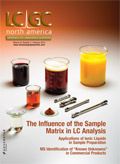Troubleshooting GC Gas Supply, Sample Preparation, and Inlets
The first three important stages in any GC analysis are explained.
During 2013 we will present a series of short articles on gas chromatography (GC) troubleshooting and maintenance. In this first installment, we concentrate on the first three important stages in any GC analysis, namely the quality and type of gases supplied to the instrument, key sample preparation considerations, and common problems encountered with the most popular sample inlet for GC: the split–splitless injector.
Gases commonly used in GC include nitrogen, hydrogen, and helium for the carrier gas, hydrogen for flame ionization detection (FID), and nitrogen, or less favorably helium, as the make-up gas for ionizing detectors. The carrier gas should be free from moisture and oxygen, both of which cause increased stationary-phase bleed, poor peak shape, and reduced sensitivity. Alumina in-line filters (traps) should be fitted as close as possible to the instrument. Self-indicating traps are preferred as the indicator is a tell-tale to signal that the trap is exhausted and needs to be changed. FID and other ionizing detector gases should be free of hydrocarbons that can reduce sensitivity; a hydrocarbon trap is recommended. Other detector types have specific gas purity requirements, and mass spectrometry (MS) detectors, for example, need to have large-capacity oxygen traps fitted. In general, the gases used should be 99.999% pure or better. A periodic "pressure drop" test should be carried out on gas lines to test for leaks in the supply lines — usually achieved by switching off all GC systems, closing the cylinder head regulator (or switching off the gas generator production), and then monitoring the line pressure for a significant pressure drop, which indicates a non-pressure-tight line between the gas supply and the instrument.
Sample solvents should be chosen to ensure compatibility with the GC column stationary phase to avoid peak shape effects such as broadening, splitting, and shouldering. Match the sample-solvent polarity with the stationary-phase polarity to avoid these effects: For example, the use of water or methanol as sample solvent with methyl silicone stationary phase or hexane with PEG or Wax phases is not recommended. Different sample solvents produce different volumes of vapor in the inlet, and one should test that the amount of vapor created does not exceed the available volume within the liner; otherwise "backflash" may occur in which analyte is deposited in the carrier gas and septum lines that can lead to carry-over and irreproducible quantitative results. There is a dedicated software calculator available within CHROMacademy to assist with this test.
Leaking septa give rise to baseline shifts during injection, pressure problems, and poor quantitative reproducibility. Check or replace the septum before each campaign of analyses. Periodically verify the septum purge flow with a flowmeter to avoid noisy baselines with spurious peaks and reduced sensitivity.
The inlet liner should be appropriate to the injection mode and will, over time, become active toward analytes with polar functional groups. The glass wool and quartz glass surface are typically silylated (deactivated) when new; however, the derivatizing reagent hydrolyses over time and exposure to moisture exposes silanol groups, which causes a secondary, unwanted, retention to a proportion of the analyte molecules and, consequently, significant peak tailing. Clean, deactivate, or replace liners or glass wool as necessary to reduce peak tailing and overcome problems with peak area reproducibility.
Ensure that the column is positioned within the inlet according to manufacturers' instructions to avoid problems with quantitative reproducibility.
Clean the inlet walls and any metallic seals at the lower and upper part of the inlet periodically using both polar and nonpolar solvents to ensure good peak shape and quantitative reproducibility.
Periodically check the flow rate of the split gas from the inlet in both the split and splitless (where the flow should be zero) modes with a flowmeter to check for issues with blocking of the split gas lines, the viability and accuracy of the split flow regulator and to test the operation of the solenoid valve that toggles between split and splitless modes.
To optimize peak efficiency (sharp Gaussian peaks), reduce tailing of the solvent peak, and avoid rising baselines during the analysis, ensure that during splitless injection the initial oven temperature is at least 10 °C below the sample solvent boiling point and that the inlet switches to split mode at an optimum time after injection to purge inlet of residual vapors. The optimum split-on (purge) time can be estimated by monitoring peak area with purge times starting at around 20 s after injection and increasing in 10-s steps. The purge time corresponding to the first repeatable peak area measurement should be chosen as the split-on time — that is, if peak areas are reproducible for the 30- and 40-s purge times then 40 s is chosen as the split-on time.
Check out the on-line interactive CHROMacademy GC Troubleshooter for a wealth of GC troubleshooting and maintenance information.

New Study Reviews Chromatography Methods for Flavonoid Analysis
April 21st 2025Flavonoids are widely used metabolites that carry out various functions in different industries, such as food and cosmetics. Detecting, separating, and quantifying them in fruit species can be a complicated process.
University of Rouen-Normandy Scientists Explore Eco-Friendly Sampling Approach for GC-HRMS
April 17th 2025Root exudates—substances secreted by living plant roots—are challenging to sample, as they are typically extracted using artificial devices and can vary widely in both quantity and composition across plant species.
Sorbonne Researchers Develop Miniaturized GC Detector for VOC Analysis
April 16th 2025A team of scientists from the Paris university developed and optimized MAVERIC, a miniaturized and autonomous gas chromatography (GC) system coupled to a nano-gravimetric detector (NGD) based on a NEMS (nano-electromechanical-system) resonator.
Miniaturized GC–MS Method for BVOC Analysis of Spanish Trees
April 16th 2025University of Valladolid scientists used a miniaturized method for analyzing biogenic volatile organic compounds (BVOCs) emitted by tree species, using headspace solid-phase microextraction coupled with gas chromatography and quadrupole time-of-flight mass spectrometry (HS-SPME-GC–QTOF-MS) has been developed.












